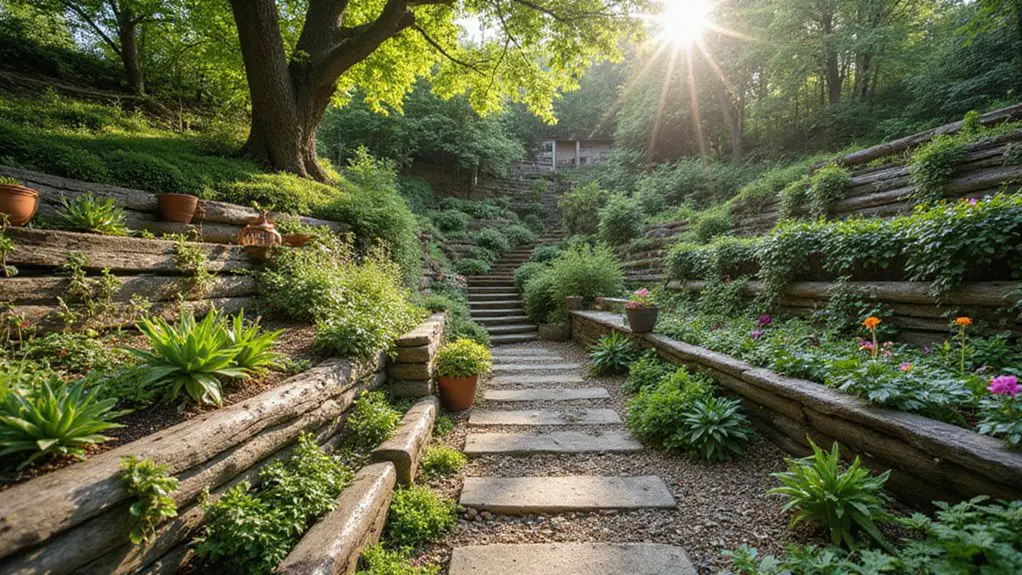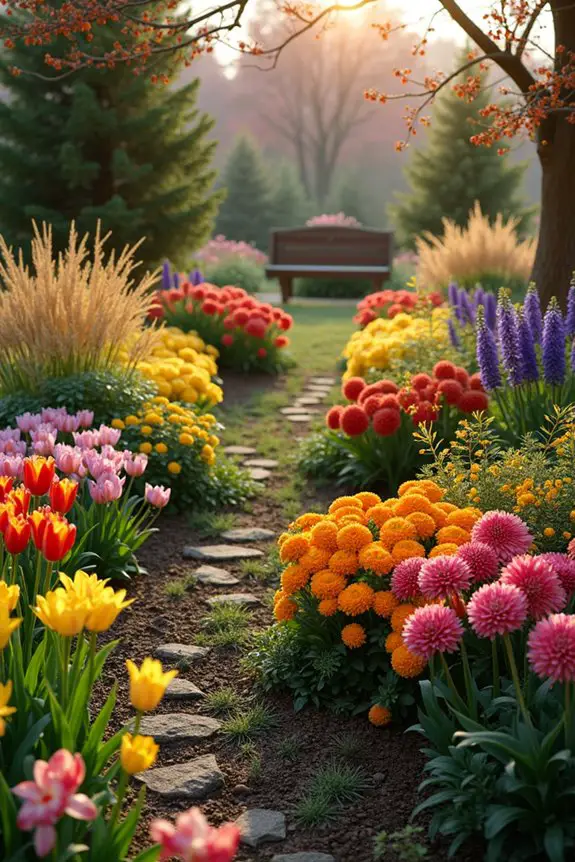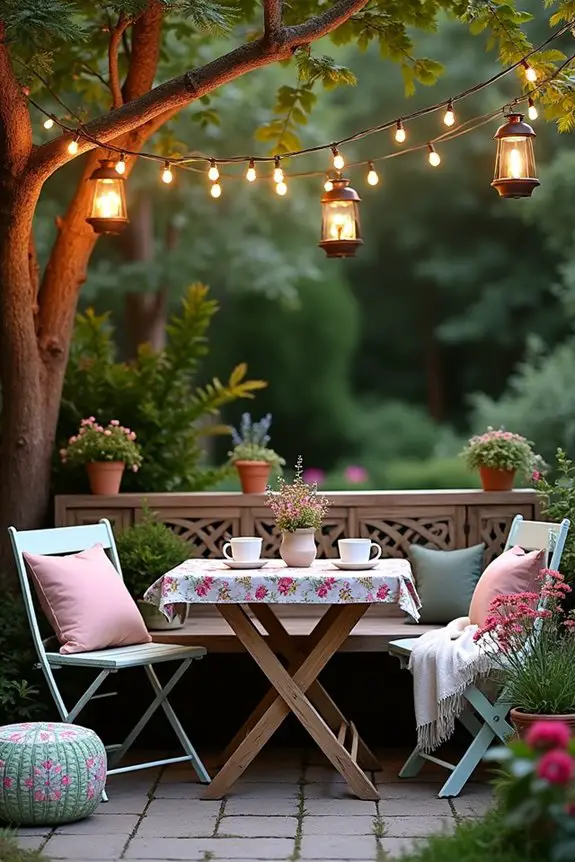Creating a terraced garden can be an enjoyable endeavor, even on a modest budget. The right design can enhance both the aesthetics and functionality of a space. With various options, such as using recycled materials or incorporating companion planting techniques, the possibilities are vast. Individuals seeking a vibrant garden may find that clever planning can lead to remarkable results. What innovative solutions await those willing to explore further?
Greenhouse Terraced Kitchen Garden
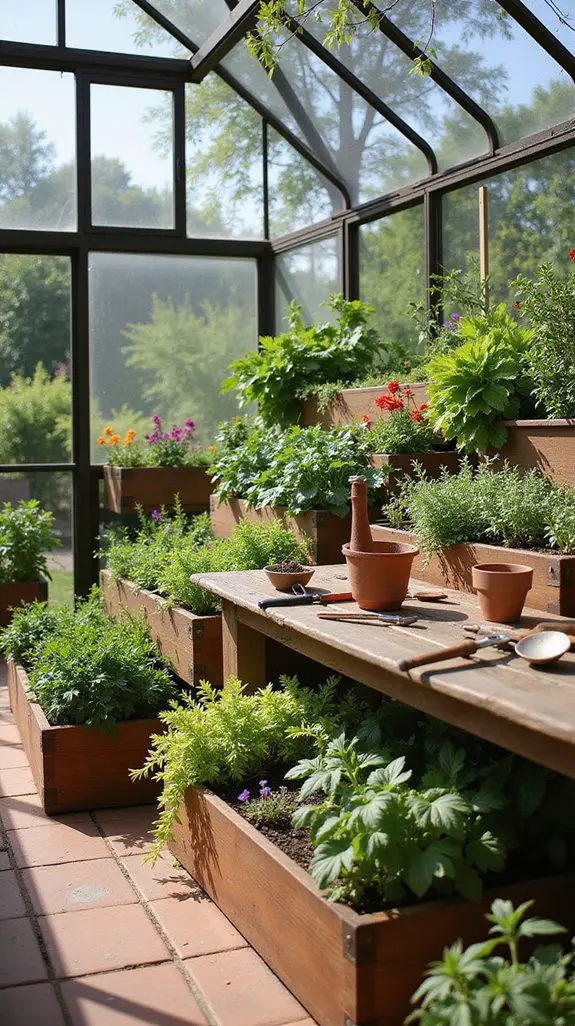
Although space may be limited, a greenhouse terraced kitchen garden offers an innovative solution for maximizing vegetable production.
Elevated timber beds create distinct growing zones, allowing for efficient organization and planting. Gravel pathways enhance drainage and provide easy access to each bed.
The design optimizes sunlight exposure, ensuring that smaller plants receive adequate light without being overshadowed.
Vibrant blue cornflowers can be incorporated, adding a splash of color to the primarily green palette.
Over time, the wooden raised beds develop a silver patina, contributing to the garden’s aesthetic.
Additionally, using a quality border edging spade helps create clean edges and defined borders, enhancing the overall appearance of the garden.
This approach combines functionality with beauty, making it an ideal gardening option.
Hillside Edible Terraces
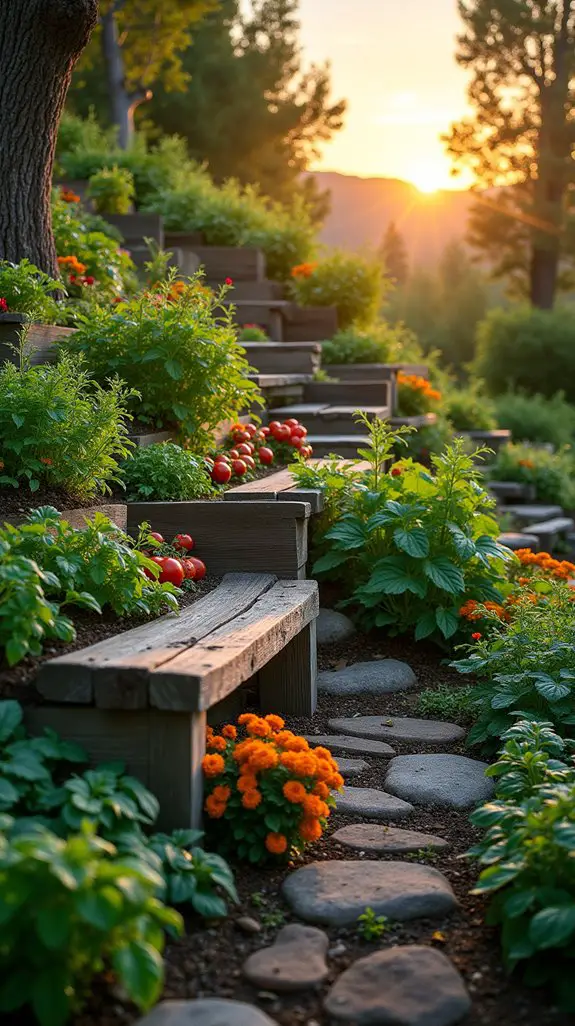
When considering limited space for gardening, hillside edible terraces present an effective solution to maximize agricultural potential while preventing soil erosion. These terraces utilize wooden retaining walls to create stable planting areas, promoting healthy growth while maintaining soil integrity. Additionally, incorporating UV grow light sterilizers can enhance plant health by ensuring a clean environment for your crops. For efficient planting and transplanting, using tools like a transplanting trowel garden can significantly ease the process.
Trellises support climbing vegetables, allowing for vertical gardening and efficient space use. Implementing companion planting enhances biodiversity and efficiency, fostering a harmonious environment among plants. Concrete blocks can serve as path edging, offering durability and thermal mass to retain heat. This arrangement not only decorates the hillside but also strategically organizes the garden for easy access and maintenance. Additionally, using tools like the elegant garden trug wicker can help in efficiently transporting harvested produce.
Mediterranean Terraced Stonework Garden
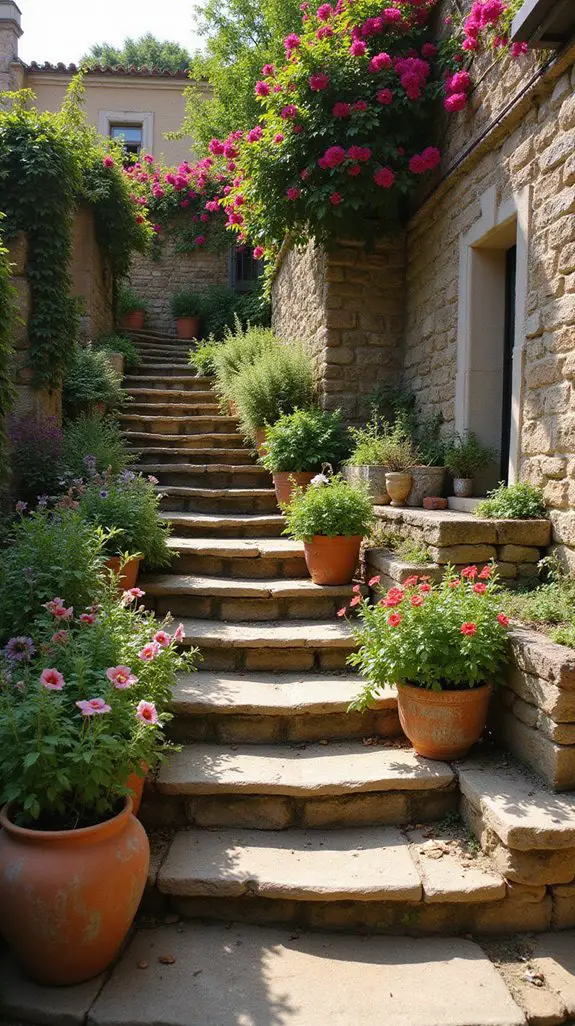
Building on the concepts of stability and design from hillside edible terraces, a Mediterranean terraced stonework garden offers a unique approach to cultivating plants in a sloped landscape.
Stone walls establish functional growing zones, while tall cypress trees provide vertical accents connecting the tiers. This structured stonework merges formality with abundant wild plant life, creating visually appealing terraces. These gardens often require skilled maintenance, making tools such as anvil pruning shears essential for preserving plant health and structure. Additionally, having mini bonsai shears on hand can help you with precise trimming in tight spaces. Using ratchet pruning shears can greatly reduce strain on your hands and improve efficiency during maintenance tasks.
Each level generates microclimates, supporting diverse plant types and maximizing sunlight exposure. As one ascends, the garden reveals varying experiences, showcasing beauty through strategic plant placements and the rustic charm of stone, enhancing both aesthetics and ecological harmony in the garden. Utilizing tools such as long handled pruning loppers can greatly aid in maintaining the structure and health of the plants in this beautifully designed space.
Minimalist Terraced Water Feature
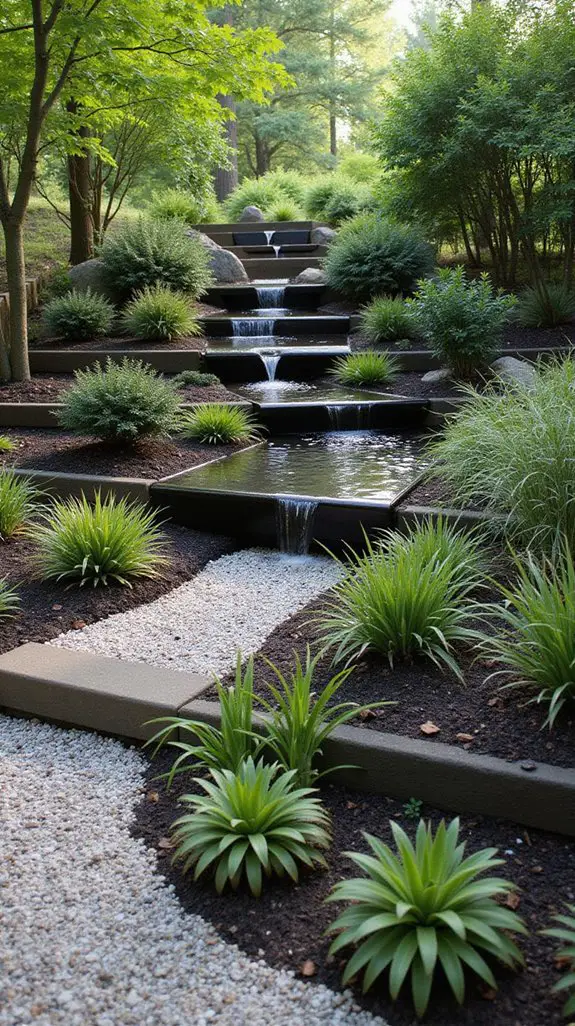
A minimalist terraced water feature transforms the garden into a serene retreat that balances simplicity with elegance.
The design incorporates clean lines and a sleek water bowl, which serves as a striking focal point. Architectural plants are strategically placed to create bold shapes against the smooth walls, enhancing the overall aesthetic. Integrating a soaker hose splitter can streamline watering your terraced garden, ensuring even moisture distribution. Using a soaker hose system can further enhance the efficiency of watering by delivering moisture directly to plant roots.
The terraced layout allows for multiple viewing angles, making it a dynamic element in the garden.
At night, strategically placed lighting highlights the intricate textures of plants and the calming ripples of water, creating an inviting atmosphere that promotes relaxation and contemplation in the garden space. Incorporating vermiculite soil additive can improve the overall health of the garden, supporting lush plant growth.
Edible Terraced Garden Paradise
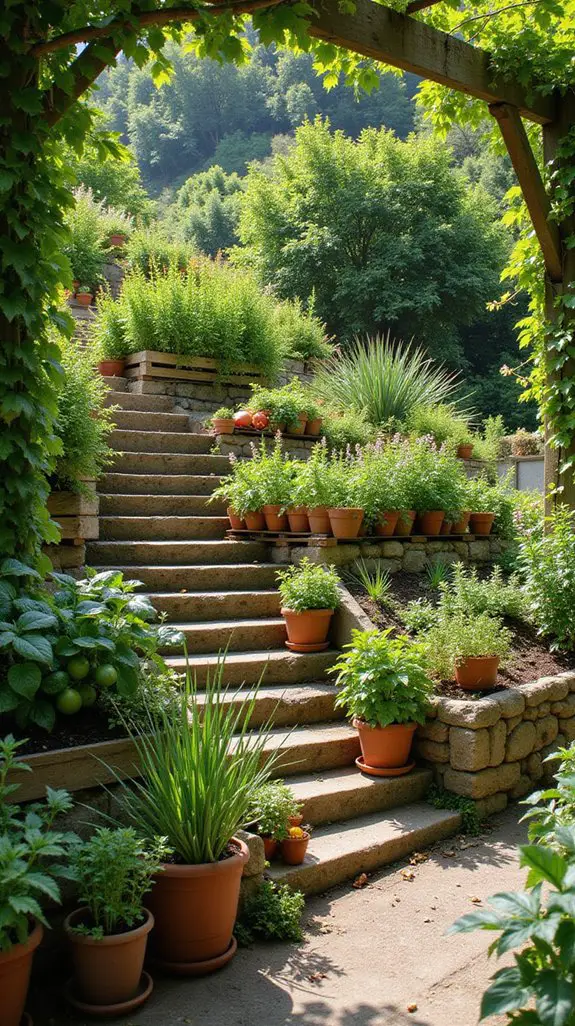
Creating an edible terraced garden paradise transforms any modest yard into a vibrant tapestry of growth and productivity.
Golden wooden raised beds form a sunny amphitheater, optimizing space across multiple levels. Climbing vegetables flourish on the upper tiers, while leafy greens occupy the shaded lower areas. Incorporating garden leaf scoops can simplify the process of clearing debris and maintaining the garden’s neat appearance. A handy garden hand fork is essential for turning soil and planting seeds in these raised beds. Utilizing a garden planner journal can further streamline the design and planting process, allowing for thoughtful organization and tracking of your garden’s progress.
Carefully designed walking paths manage water flow between these levels, ensuring adequate drainage and nurturing conditions. Durable concrete blocks further reinforce the longevity of wooden structures, providing stability and aesthetic appeal.
This strategic arrangement encourages biodiversity and harvest efficiency, making the garden not only a source of food but also a beautiful outdoor retreat. Additionally, incorporating a versatile garden hose nozzle can enhance your watering efficiency, allowing for tailored watering to meet different plant needs.
Hillside Timber Terraced Garden
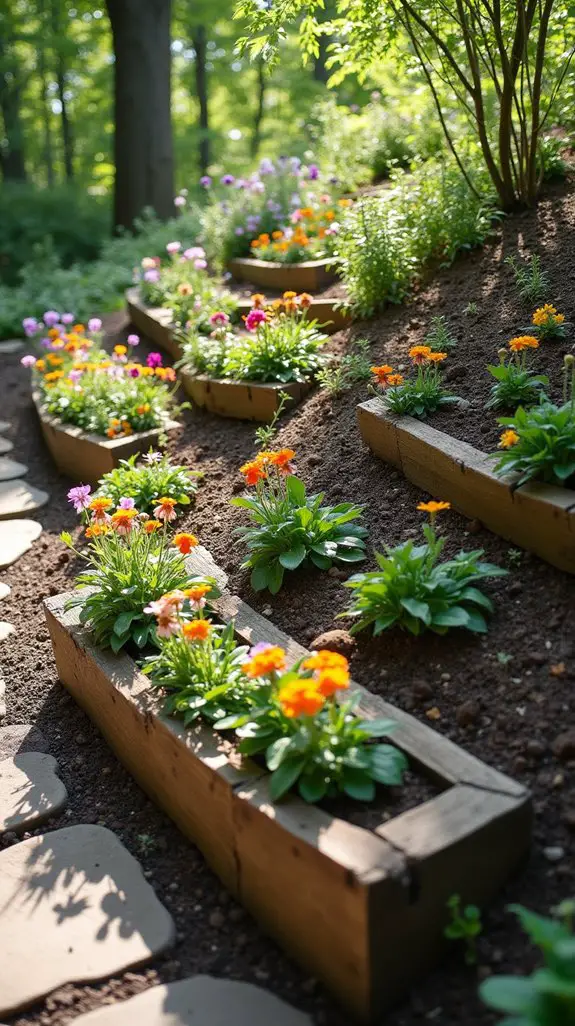
Natural timber retaining walls elegantly define the levels of a hillside timber terraced garden, transforming sloped terrain into productive planting beds.
This design effectively follows the natural contours of the land, preventing soil erosion while maximizing the available growing area. Incorporating a drip irrigation emitter kit can greatly enhance water delivery efficiency to your plants. Additionally, using a WiFi smart watering timer can automate the irrigation process, ensuring your garden receives consistent moisture even when you’re not around. Integrating a drip irrigation timer will further optimize your watering schedule, providing precise control over how much water your plants receive.
Stepping blocks interspersed between the beds provide stable footing, enhancing accessibility.
Mulched pathways control water runoff, ensuring the garden remains manageable during heavy rains.
The open layout fosters good air circulation, reducing the risk of plant diseases. Additionally, incorporating a drip irrigation tubing kit can optimize water usage and ensure your plants receive the moisture they need efficiently.
Formal Terraced Hedge Garden
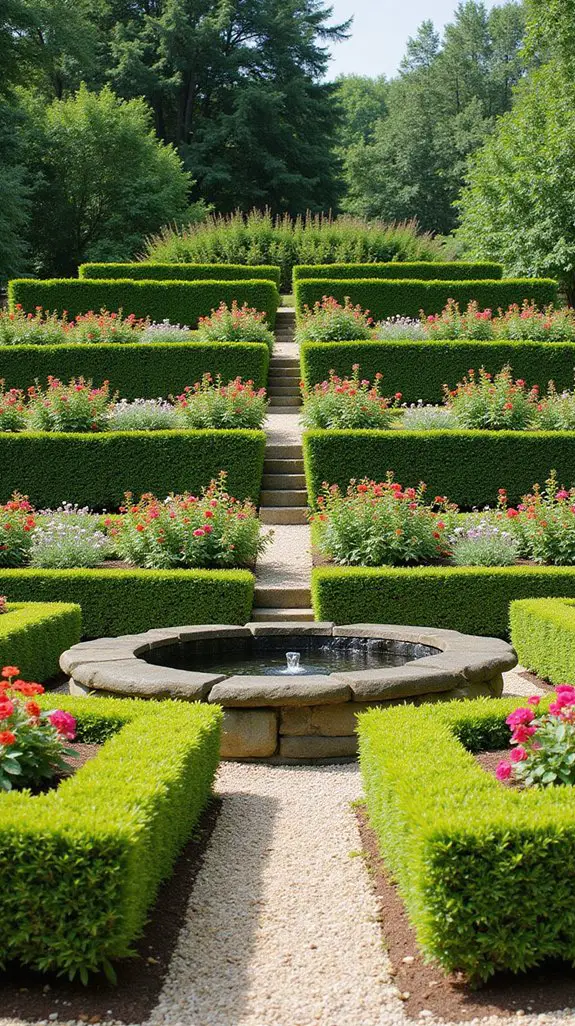
Defined by crisp boxwood balls, the formal terraced hedge garden offers a structured aesthetic that contrasts beautifully with the natural contours of the landscape. Incorporating immaculate hydrangeas, it provides seasonal blooms that add depth to the greenery. Varying plant heights create a natural terracing effect, enhancing visual interest. Understanding the soil pH level is essential for selecting the right plants for this type of garden. Incorporating a stylish metal trellis can further elevate the garden’s design, allowing climbing plants to flourish. Additionally, testing your soil for key nutrient levels can help ensure optimal growth and vibrancy.
Strategic pruning maintains the geometric shapes essential to its formal style, ensuring the garden remains polished and tailored. Each tier can establish distinct microclimates, benefiting specific plants. The formal terraced hedge garden serves as an exquisite blend of architectural design and botanical elegance, appealing to those appreciating symmetry and sophistication in outdoor spaces. Adding a digital soil test kit can enhance plant health by providing crucial insights into soil composition.
Unique Plant Combinations
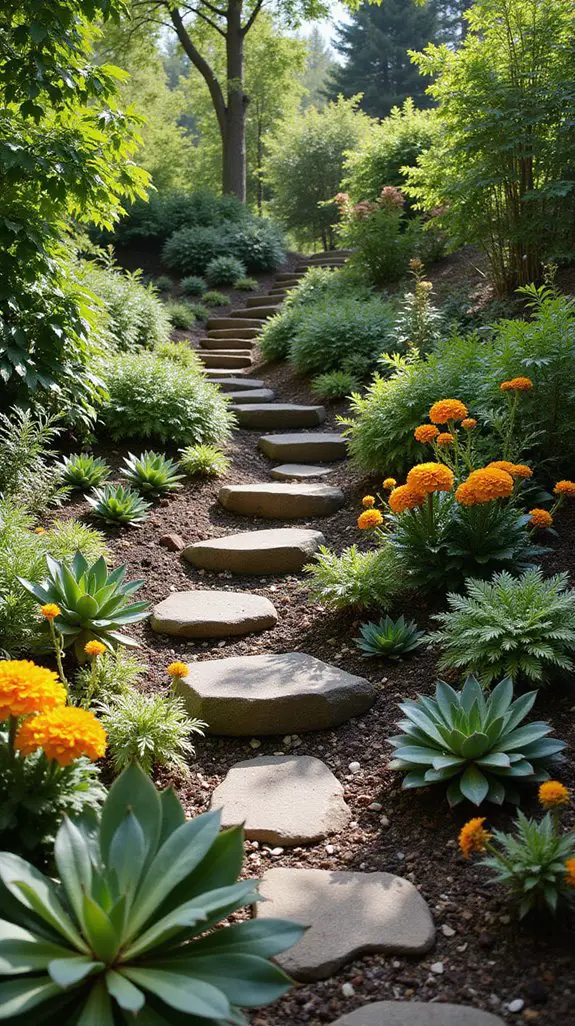
How can unique plant combinations transform a garden into a thriving ecosystem? By employing principles of companion planting, gardeners can enhance biodiversity, allowing different plant families to coexist harmoniously.
Mixing herbs, vegetables, and flowers not only provides visual allure but also increases growth efficiency and pest resilience. A diverse planting scheme can include options like wildflower seed mix bulk, which attracts pollinators and improves soil health. A garden foraging bag can assist in easily gathering edible plants and herbs from the garden. Seasonal variations in plant heights and colors further enrich the landscape, drawing beneficial wildlife and creating a vibrant atmosphere. Additionally, incorporating artificial garden hedges can enhance privacy and define spaces within the garden, further contributing to its overall beauty and functionality. Moreover, using self-watering hanging baskets can simplify maintenance and ensure that plants receive consistent moisture, promoting healthy growth.
Thoughtfully placed combinations encourage natural pest control, reducing the need for chemical interventions. Ultimately, such strategic diversity cultivates a more balanced and productive garden, fostering sustainability and ecological health.
Pathway Design and Materials
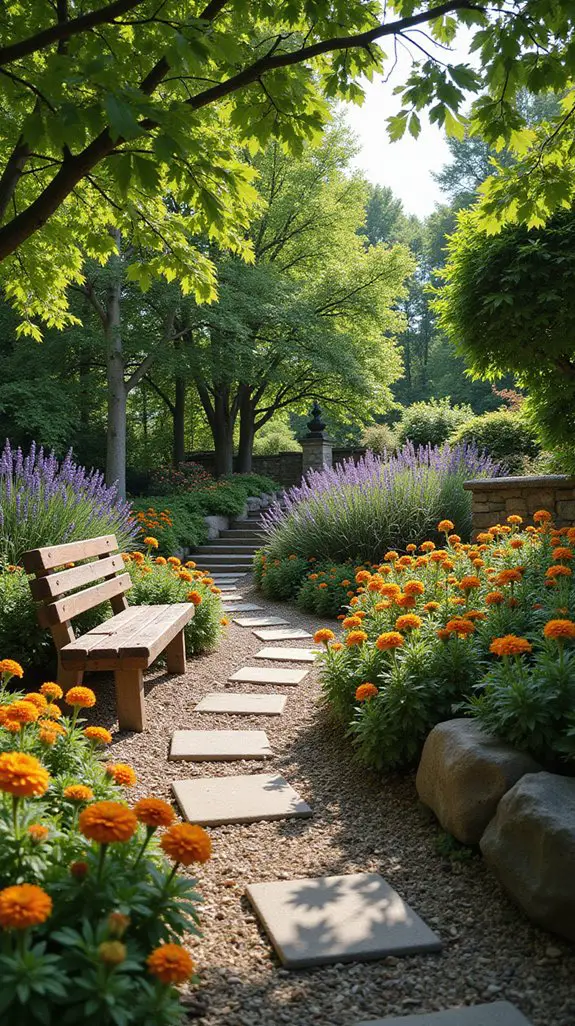
Unique plant combinations not only enhance the aesthetic appeal of a garden but also influence its overall functionality, making thoughtful pathway design and material selection paramount. Additionally, a good quality garden bulb planter can greatly expedite the planting process and ensure that bulbs are placed at the optimal depth. Furthermore, incorporating an aeroponic growing system can maximize space and yield, allowing for a beautiful integration of vertical gardening with your pathways.
Gravel pathways serve to facilitate drainage and provide easy access between beds, while stepping stones can define pathways through central areas. Additionally, natural pathways effectively manage water flow, enhancing both function and beauty. Concrete blocks add structural integrity and thermal mass along these routes. An effective way to maintain these pathways is by utilizing a dandelion weeder tool, which can help keep weeds at bay without disturbing the surrounding soil.
Choosing the right garden umbrella base stand can also complement your garden’s layout and provide shade, enhancing the overall experience of your outdoor space.
Microclimate Creation
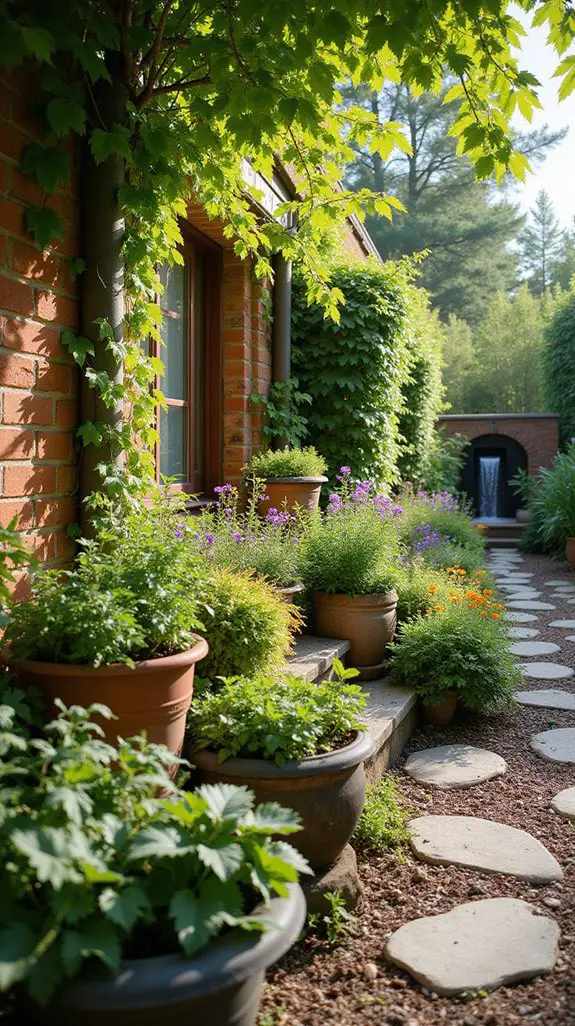
Microclimate creation plays an essential role in enhancing plant growth within terraced gardens.
The design of terraced spaces allows for diverse climatic conditions, with upper tiers capturing more heat, benefiting sun-loving plants like tomatoes. In contrast, the lower tiers create cooler environments ideal for moisture-loving varieties. Incorporating humidity domes with vents can further optimize these conditions by regulating moisture levels. Additionally, using essential garden scissors ensures precise plant care, supporting the unique needs of various microclimates. A well-maintained garden folding saw is invaluable for trimming larger branches, ensuring your plants receive ample light to thrive.
Strategic arrangements further enhance irrigation, preventing waterlogged roots and promoting drainage.
Implementing erosion control measures not only protects the soil but also contributes to varied microclimates, fostering an ecosystem that can support a wider array of plants. Additionally, using fabric aeration pots helps improve root health and promotes better drainage, aligning perfectly with microclimate strategies.
Aesthetic Enhancements
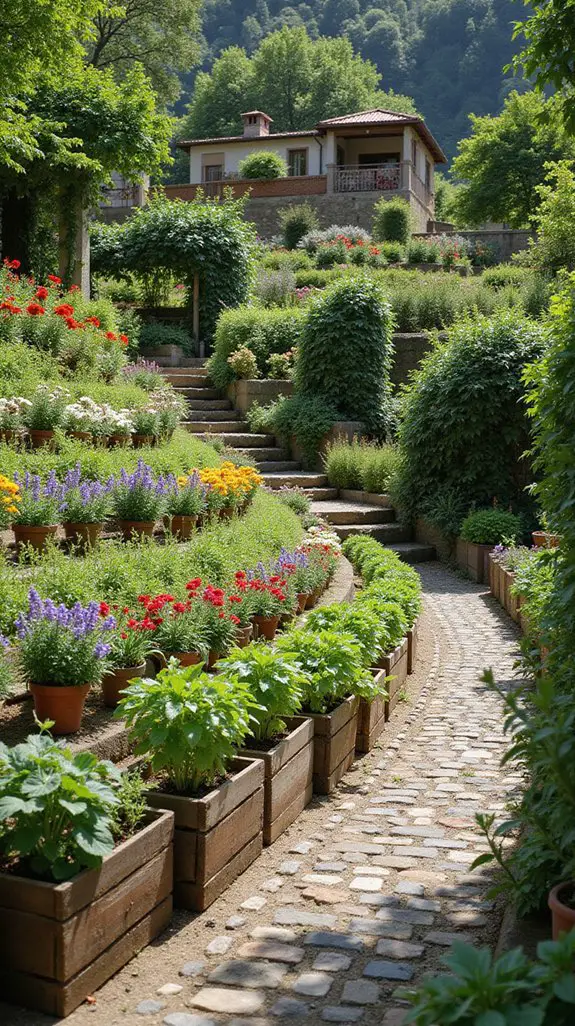
Aesthetic enhancements considerably elevate the appeal of terraced gardens, transforming them into vibrant landscapes. The interplay of color, from blooming flowers to lush foliage, adds visual dynamism.
Wooden structures, with their evolving character over time, harmonize beautifully with the surrounding environment. Water features introduce tranquility, enriching the sensory experience.
Varied plant textures guarantee year-round visual interest, providing depth and complexity. Thoughtful design considerations further promote harmony with the natural landscape, creating a cohesive aesthetic.
Gardening Layout and Access
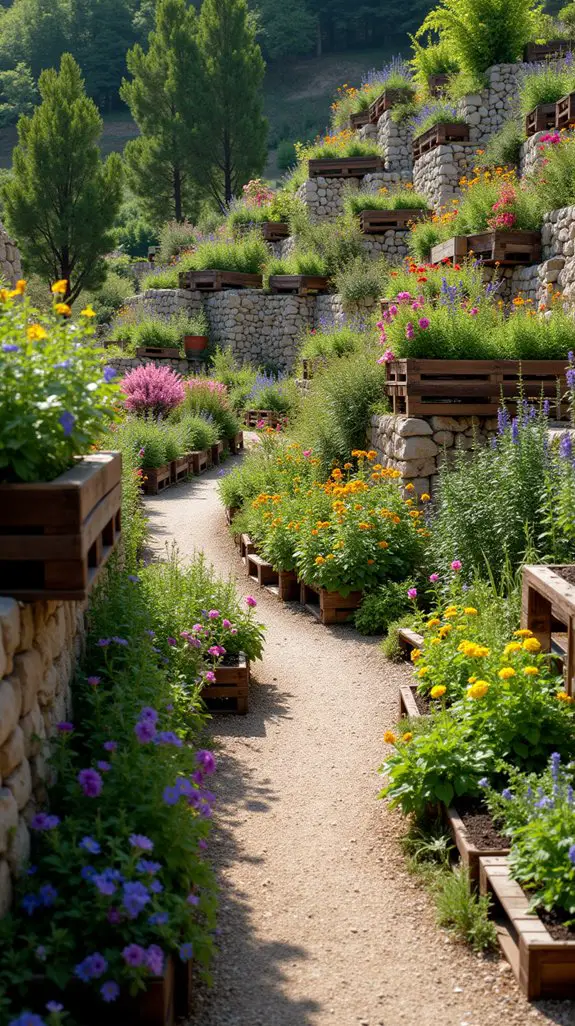
The layout and access in terraced gardens play a pivotal role in guaranteeing both functionality and beauty. Defined garden rooms, created through thoughtful elevation, enhance visual interest while guiding exploration.
Central axes streamline movement, making it easier to navigate the garden for maintenance and harvesting. Paths should be strategically designed using materials like gravel or stepping stones to guarantee durability and drainage.
This straightforward layout supports efficient gardening practices, enabling quick access to different areas. By prioritizing organization and accessibility, terraced gardens can thrive while providing a seamless experience for those tending to their plants.
Seasonal Considerations
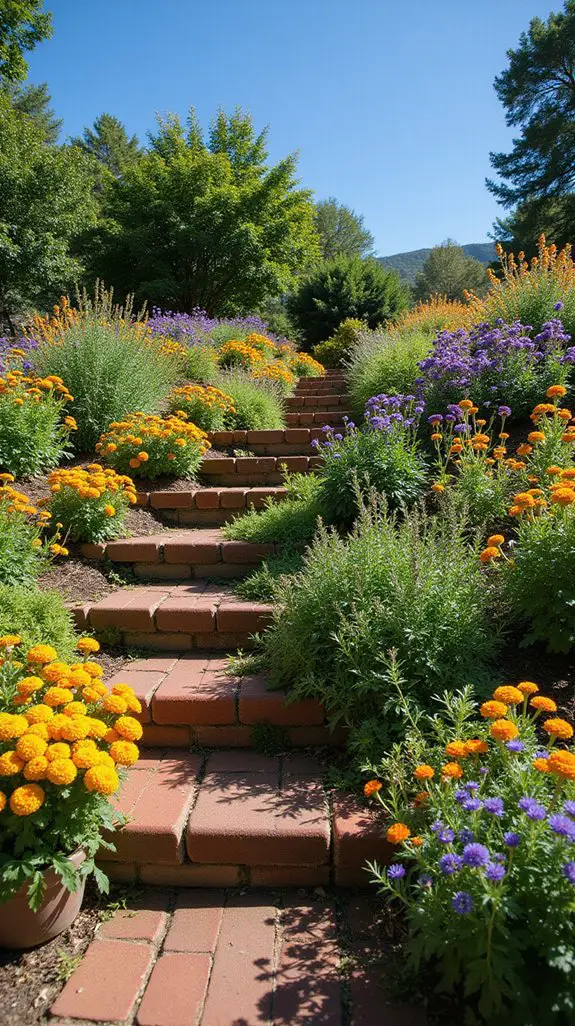
While planning a terraced garden, seasonal considerations greatly influence plant selection and overall design. Gardeners must account for temperature variations throughout the year, choosing plants suited to both warm and cool seasons.
Autumn brings vibrant colors, enhancing the garden’s visual appeal. Implementing strategies for extended growing seasons, such as utilizing greenhouses, allows for year-round cultivation.
Additionally, seasonal adjustments in crop rotations help manage pests effectively. By optimizing sunlight exposure across various tiers, the garden can support a diverse range of plants, ensuring that each level thrives in accordance with its unique seasonal characteristics.
Sustainability Practices
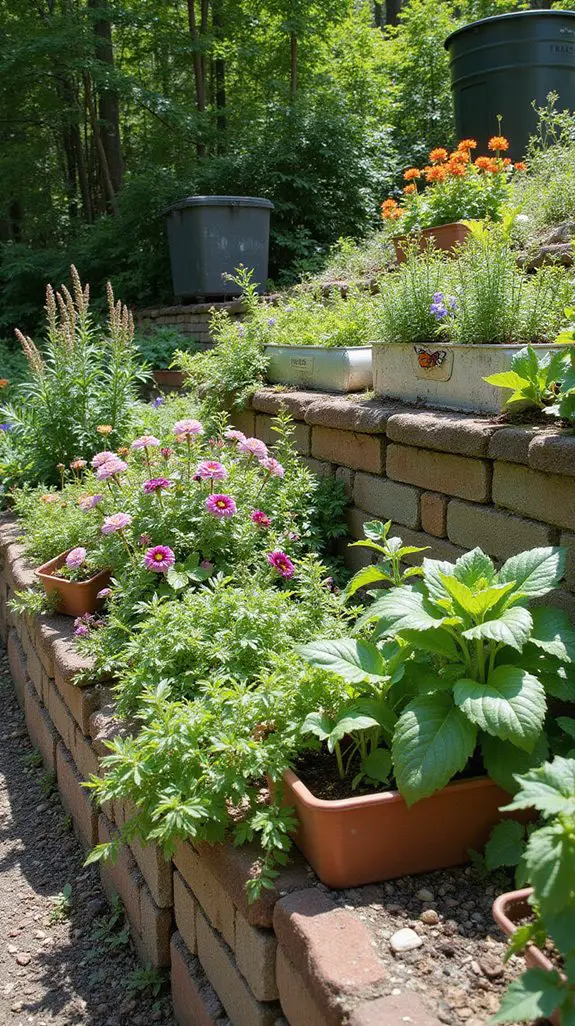
Incorporating sustainability practices into terraced gardens not only enhances their ecological footprint but also promotes long-term resilience.
Utilizing natural materials minimizes environmental impact while fostering a connection with the landscape. Companion planting supports organic pest management, reducing the need for chemical interventions.
Implementing mulching techniques retains moisture in the soil and decreases runoff, ultimately conserving water resources. Vertical gardening maximizes space efficiency, allowing for diverse plant growth in limited areas.
Additionally, efficient crop rotation and planning minimize waste, ensuring that the garden remains productive throughout the seasons.
These practices collectively contribute to a thriving and sustainable terraced garden.
Design Principles
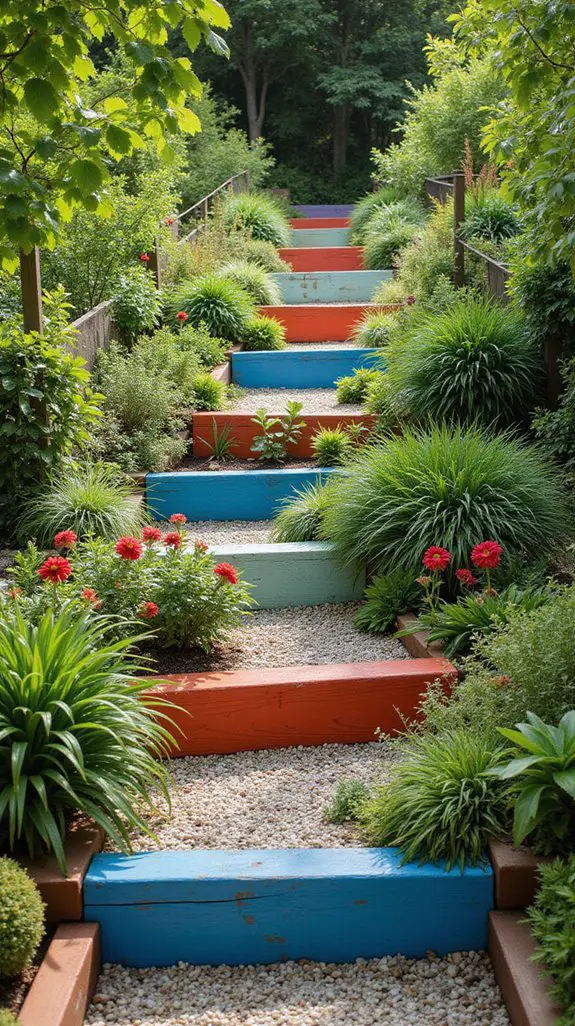
Effective design principles play an essential role in creating a harmonious terraced garden, as they balance structural organization with the natural abundance of plant life. Achieving this balance often involves the use of geometric shapes to guide overall organization, while careful plant selection fosters visual connections between various garden levels.
Seasonal interest can be emphasized through strategic planting, ensuring color and texture change throughout the year. Additionally, integrating the garden with the natural landscape enhances cohesion, creating a space that feels both inviting and functional.
Therefore, thoughtful design becomes vital for maximizing the terraced garden’s aesthetic and practical potential.
Conclusion
In conclusion, creating a terraced garden on a budget is entirely feasible with thoughtful planning and resourceful choices. By utilizing recycled materials, incorporating companion planting, and designing efficient layouts, anyone can cultivate a vibrant and productive space. Whether it’s a greenhouse kitchen garden or a minimalist water feature, the possibilities are endless. With creativity and sustainable practices, these terraced garden ideas can transform any outdoor area into a flourishing haven without straining the wallet.

